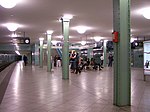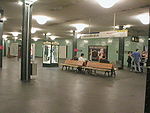Berlin Alexanderplatz station
Berlin Alexanderplatz | |
|---|---|
| Bf | |
 | |
| General information | |
| Location | Mitte, Berlin Germany |
| Coordinates | 52°31′17″N 13°24′43″E / 52.52139°N 13.41194°E |
| Line(s) | |
| Other information | |
| Station code | 53 |
| DS100 code | BALE |
| Category | 3[1] |
| Website | www.bahnhof.de |
| History | |
| Opened | 1882 |
Berlin Alexanderplatz is a railway station in the Mitte district of Berlin's city centre. It is one of the busiest transport hubs in the Berlin area. The station is named for the Alexanderplatz square on which it is located, near the Fernsehturm and the World clock.
Overview

Like other long-distance stations, Alexanderplatz is also a shopping centre for selling merchandise to travelers. Due to its importance and central location, it is a site where tourists regularly change. Alexanderplatz thereby became beside Nollendorfplatz station the second major hub of the Berlin U-Bahn network.
Four Regional-Express and Regionalbahn lines as well as the S-Bahn rapid transit lines Template:SBB lines, Template:SBB lines and Template:SBB lines call at the overground station. The adjacent underground station is one of the largest on the Berlin U-Bahn network, with the lines Template:BVG lines, Template:BVG lines and Template:BVG lines calling. The station is also served by four tram lines, two of which run continuously, as well as five bus lines during the day, one of which runs continuously and three night bus lines. Alexanderplatz is also connected through the two tunnel links, from U2 to U5 and U5 to U8.
History

Alexanderplatz station opened on 7 February 1882 on the Berlin Stadtbahn viaduct from Charlottenburg to Ostbahnhof (then named Schlesischer Bahnhof). In 1926 the station hall spanning two platforms with four tracks was rebuilt in its present plain style. Heavily damaged in World War II, train service at the station was resumed on 4 November 1945, while the reconstruction of the hall continued until 1951.
The first U-Bahn station of the present U2 line designed by Alfred Grenander entered service on 1 July 1913; then the eastern terminus of Berlin's second line from Potsdamer Platz via Spittelmarkt. The platforms of the U8 and the U5 opened on 18 April 1930 and 21 December 1930 respectively, also built according to Grenander's conception, but in a distinct Modern style. The U2 station was also renovated after the Alexanderplatz fire in 1972.
The U8 station was also a ghost station during the division of Berlin from 13 August 1961 to 1 July 1990. The station master offices were also built; these were shifted and walls were removed. The access at Dierksenstraße had to be made accessible again, just like the connecting stairs to the mall and to the platforms of Line E. Other than that, the intercommunication staircase was also built towards Line E so that it goes through the dimly lit platforms. Stainallee was renamed a few months after the closure of the stairs. In all cases, the metro stations had to be recognizable as such on the surface . The U-Bahn logo has been removed in recent years. This station also had to undergo renovation works from 17 May to 30 June 1990 before the full reopening on 1 July 1990.
The U5 station underwent renovation works from February 2003 to September 2004.
Gallery
-
U2 platforms, looking to the north
-
U2 platforms
-
U5 platforms
-
U5 platforms, with a new H type waiting to depart for Honow
-
U8 platforms
-
U8 platforms, before its 2004 renovation
-
Flexity Berlin tram at Alexanderplatz
-
Metro-Bear-Berlin: This Buddy Bear with its map of the Berlin U-Bahn and S-Bahn can be found in the Alexanderplatz station
Notes
- ^ "Stationspreisliste 2025" [Station price list 2025] (PDF) (in German). DB Station&Service. 28 November 2024. Retrieved 5 December 2024.
External links
![]() Media related to Berlin Alexanderplatz station at Wikimedia Commons
Media related to Berlin Alexanderplatz station at Wikimedia Commons








